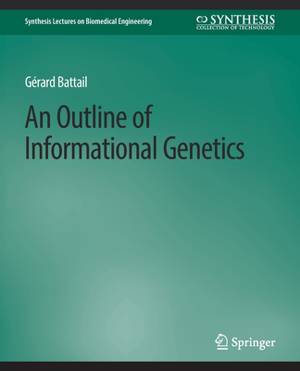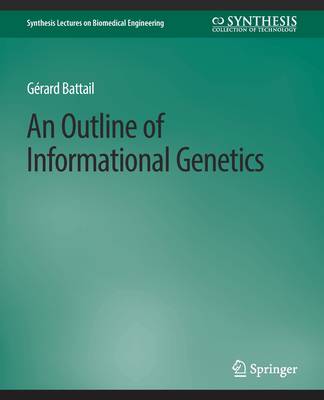
- Retrait gratuit dans votre magasin Club
- 7.000.000 titres dans notre catalogue
- Payer en toute sécurité
- Toujours un magasin près de chez vous
- Retrait gratuit dans votre magasin Club
- 7.000.000 titres dans notre catalogue
- Payer en toute sécurité
- Toujours un magasin près de chez vous
Description
Heredity performs literal communication of immensely long genomes through immensely long time intervals. Genomes nevertheless incur sporadic errors referred to as mutations which have significant and often dramatic effects, after a time interval as short as a human life. How can faithfulness at a very large timescale and unfaithfulness at a very short one be conciliated? The engineering problem of literal communication has been completely solved during the second half of the XX-th century. Originating in 1948 from Claude Shannon's seminal work, information theory provided means to measure information quantities and proved that communication is possible through an unreliable channel (by means left unspecified) up to a sharp limit referred to as its capacity, beyond which communication becomes impossible. The quest for engineering means of reliable communication, named error-correcting codes, did not succeed in closely approaching capacity until 1993 when Claude Berrou and Alain Glavieux invented turbocodes. By now, the electronic devices which invaded our daily lives (e.g., CD, DVD, mobile phone, digital television) could not work without highly efficient error-correcting codes. Reliable communication through unreliable channels up to the limit of what is theoretically possible has become a practical reality: an outstanding achievement, however little publicized. As an engineering problem that nature solved aeons ago, heredity is relevant to information theory. The capacity of DNA is easily shown to vanish exponentially fast, which entails that error-correcting codes must be used to regenerate genomes so as to faithfully transmit the hereditary message. Moreover, assuming that such codes exist explains basic and conspicuous features of the living world, e.g., the existence of discrete species and their hierarchical taxonomy, the necessity of successive generations and even the trend of evolution towards increasingly complex beings. Providing geneticists with an introduction to information theory and error-correcting codes as necessary tools of hereditary communication is the primary goal of this book. Some biological consequences of their use are also discussed, and guesses about hypothesized genomic codes are presented. Another goal is prompting communication engineers to get interested in genetics and biology, thereby broadening their horizon far beyond the technological field, and learning from the most outstanding engineer: Nature. Table of Contents: Foreword / Introduction / A Brief Overview of Molecular Genetics / An Overview of Information Theory / More on Molecular Genetics / More on Information Theory / An Outline of Error-Correcting Codes / DNA is an Ephemeral Memory / A Toy Living World / Subsidiary Hypothesis, Nested System / Soft Codes / Biological Reality Conforms to the Hypotheses / Identification of Genomic Codes / Conclusion and Perspectives
Spécifications
Parties prenantes
- Auteur(s) :
- Editeur:
Contenu
- Nombre de pages :
- 191
- Langue:
- Anglais
- Collection :
Caractéristiques
- EAN:
- 9783031005015
- Date de parution :
- 22-09-08
- Format:
- Livre broché
- Format numérique:
- Trade paperback (VS)
- Dimensions :
- 190 mm x 235 mm
- Poids :
- 367 g







